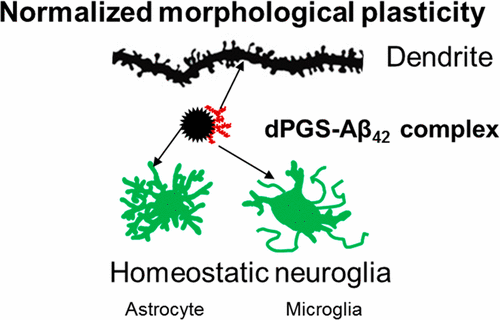当前位置:
X-MOL 学术
›
ACS Chem. Neurosci.
›
论文详情
Our official English website, www.x-mol.net, welcomes your
feedback! (Note: you will need to create a separate account there.)
Dendritic Polyglycerol Sulfates in the Prevention of Synaptic Loss and Mechanism of Action on Glia
ACS Chemical Neuroscience ( IF 4.1 ) Pub Date : 2017-11-10 00:00:00 , DOI: 10.1021/acschemneuro.7b00301 Dusica Maysinger 1 , Jeff Ji 1 , Alexandre Moquin 1 , Shireen Hossain 1 , Mark A. Hancock 1 , Issan Zhang 1 , Philip K.Y. Chang 1 , Matthew Rigby 2 , Madeleine Anthonisen 2 , Peter Grütter 2 , John Breitner 3 , R. Anne McKinney 1 , Sabine Reimann 4 , Rainer Haag 4 , Gerhard Multhaup 1
ACS Chemical Neuroscience ( IF 4.1 ) Pub Date : 2017-11-10 00:00:00 , DOI: 10.1021/acschemneuro.7b00301 Dusica Maysinger 1 , Jeff Ji 1 , Alexandre Moquin 1 , Shireen Hossain 1 , Mark A. Hancock 1 , Issan Zhang 1 , Philip K.Y. Chang 1 , Matthew Rigby 2 , Madeleine Anthonisen 2 , Peter Grütter 2 , John Breitner 3 , R. Anne McKinney 1 , Sabine Reimann 4 , Rainer Haag 4 , Gerhard Multhaup 1
Affiliation

|
Dendritic polyglycerols (dPG), particularly dendritic polyglycerol sulfates (dPGS), have been intensively studied due to their intrinsic anti-inflammatory activity. As related to brain pathologies involving neuroinflammation, the current study examined if dPG and dPGS can (i) regulate neuroglial activation, and (ii) normalize the morphology and function of excitatory postsynaptic dendritic spines adversely affected by the neurotoxic 42 amino acid amyloid-β (Aβ42) peptide of Alzheimer disease (AD). The exact role of neuroglia, such as microglia and astrocytes, remains controversial especially their positive and negative impact on inflammatory processes in AD. To test dPGS effectiveness in AD models we used primary neuroglia and organotypic hippocampal slice cultures exposed to Aβ42 peptide. Overall, our data indicate that dPGS is taken up by both microglia and astrocytes in a concentration- and time-dependent manner. The mechanism of action of dPGS involves binding to Aβ42, i.e., a direct interaction between dPGS and Aβ42 species interfered with Aβ fibril formation and reduced the production of the neuroinflammagen lipocalin-2 (LCN2) mainly in astrocytes. Moreover, dPGS normalized the impairment of neuroglia and prevented the loss of dendritic spines at excitatory synapses in the hippocampus. In summary, dPGS has desirable therapeutic properties that may help reduce amyloid-induced neuroinflammation and neurotoxicity in AD.
中文翻译:

树突状聚甘油硫酸盐预防突触丢失和胶质细胞作用机制
由于其固有的抗炎活性,已经对树突状聚甘油(dPG),特别是树突状聚甘油硫酸盐(dPGS)进行了深入研究。与涉及神经发炎的脑病理学有关,当前的研究检查了dPG和dPGS是否可以(i)调节神经胶质细胞的活化,以及(ii)使受到神经毒性42个氨基酸的淀粉样蛋白β不利影响的兴奋性突触后树突棘的形态和功能正常化( Aβ 42阿尔茨海默病)肽(AD)。神经胶质细胞(例如小胶质细胞和星形胶质细胞)的确切作用仍存在争议,尤其是它们对AD炎症过程的正面和负面影响。为了测试dPGS在AD模型中的有效性,我们使用了暴露于Aβ42的原代神经胶质细胞和器官型海马切片培养物肽。总的来说,我们的数据表明小胶质细胞和星形胶质细胞都以浓度和时间依赖性方式吸收了dPGS。DPGS的作用机制包括结合Aβ 42,即,DPGS和Aβ之间的直接相互作用42种与Aβ干扰纤维的形成和降低制造的neuroinflammagen脂笼蛋白-2(LCN2)的主要是在星形胶质细胞。此外,dPGS使神经胶质细胞损伤正常化,并防止了海马兴奋性突触中树突棘的丢失。总之,dPGS具有理想的治疗特性,可帮助减少淀粉样蛋白诱导的AD的神经炎症和神经毒性。
更新日期:2017-11-11
中文翻译:

树突状聚甘油硫酸盐预防突触丢失和胶质细胞作用机制
由于其固有的抗炎活性,已经对树突状聚甘油(dPG),特别是树突状聚甘油硫酸盐(dPGS)进行了深入研究。与涉及神经发炎的脑病理学有关,当前的研究检查了dPG和dPGS是否可以(i)调节神经胶质细胞的活化,以及(ii)使受到神经毒性42个氨基酸的淀粉样蛋白β不利影响的兴奋性突触后树突棘的形态和功能正常化( Aβ 42阿尔茨海默病)肽(AD)。神经胶质细胞(例如小胶质细胞和星形胶质细胞)的确切作用仍存在争议,尤其是它们对AD炎症过程的正面和负面影响。为了测试dPGS在AD模型中的有效性,我们使用了暴露于Aβ42的原代神经胶质细胞和器官型海马切片培养物肽。总的来说,我们的数据表明小胶质细胞和星形胶质细胞都以浓度和时间依赖性方式吸收了dPGS。DPGS的作用机制包括结合Aβ 42,即,DPGS和Aβ之间的直接相互作用42种与Aβ干扰纤维的形成和降低制造的neuroinflammagen脂笼蛋白-2(LCN2)的主要是在星形胶质细胞。此外,dPGS使神经胶质细胞损伤正常化,并防止了海马兴奋性突触中树突棘的丢失。总之,dPGS具有理想的治疗特性,可帮助减少淀粉样蛋白诱导的AD的神经炎症和神经毒性。











































 京公网安备 11010802027423号
京公网安备 11010802027423号